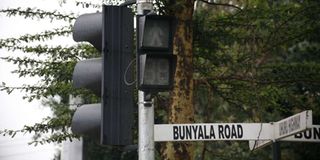Teachers in the Jomo Cabinet and inspiration behind city street names

What you need to know:
- In 1966 there was mass resignation from Kanu by members who were sympathetic to Oginga Odinga, who had resigned as Vice-President of Kanu.
- Odinga went on to form Kenya Peoples Union (KPU).
- Kenyatta elevated me to Minister for Information and Broadcasting.
When Jomo Kenyatta constituted his first Cabinet in 1963, I was appointed a parliamentary secretary (Assistant Minister) to the Ministry of Agriculture and Animal Husbandry. My minister was Bruce McKenzie, the only white in the Cabinet.
McKenzie was a very good mentor, but African MPs resented him because of his colour, which they associated with oppressive settlers. He often allowed me to answer parliamentary questions on his behalf and this prepared me very well for future debating contests.
Meanwhile, I chose a strategic sitting position next to Tom Mboya, a decision that made me feel psychologically motivated.
My election as MP and appointment as Assistant Minister gave me the opportunity to improve my personal welfare compared to my earlier days as a teacher.
LOAN SCHEME
With the parliamentary loan scheme I bought my first car, a Peugeot 404, and moved my young family to live in Jericho Estate before later on moving to South C. I was just 31 years old.
The first Parliament had 14 Cabinet ministers. Most of them were former teachers – Jomo Kenyatta, Oginga Odinga, Ngala Mwendwa, Mbiyu Koinange, Dawson Mwanyumba, Joseph Otiende, Julius Kiano, Samwel Onyango Ayodo and James Gichuru.
The non-teachers were McKenzie, Jackson Angaine, Achieng’ Oneko, Njoroge Mungai, Jackson Angaine and Tom Mboya. Charles Njonjo also sat in the Cabinet as Attorney-General.
Parliament was later expanded in 1964 to include more ministers from Kadu, and that is how more teachers like Daniel Moi and Ronald Ngala joined.
From the list of Cabinet ministers and their assistants only three are surviving by the time I wrote this book. They are Daniel arap Moi (he died in February this year), Charles Njonjo, Mwai Kibaki and I.
RESIGNATION FROM KANU
In 1966 there was mass resignation from Kanu by members who were sympathetic to Oginga Odinga, who had resigned as Vice-President of Kanu.
Odinga went on to form Kenya Peoples Union (KPU). Kenyatta elevated me to Minister for Information and Broadcasting.
I remember Mwai Kibaki and I were promoted on the same day. The post was previously held by Ramogi Achieng’ Oneko, who was also MP for Nakuru Town and had left the government with Odinga.
I became a full Cabinet minister at age 34 and served in several ministries.
These included Minister for Information and Broadcasting between 1966 and 1969, and Commerce and Industry and Acting Minister for Foreign Affairs from 1970 to 1973.
As Minister for Local Government, I raised the status of the following urban councils to town councils after my Assistant Minister, Mr Mathew Ogutu, submitted his commission report: Murang’a, Kisii, Machakos, Bungoma, Webuye, Embu and Kiambu. I also dissolved councils in Nyeri and Kiambu for performing below the required standards.
My memorable exercise in Nairobi as minister for Local Government was the renaming of some Nairobi streets.
NAMING ROADS
I remember suggesting names that were adopted like Bunyala Road, Bukani Road in Nairobi West, Hakati Road in the CBD, Rugunga Close in South C, John Osogo Road in Dandora, Wanga’apala Road, Langiri Road in Woodley, Ndekwe Road in South C, Bulemia Road in Parklands, and Busia Road in Industrial Area. I also named Nakhwanga Road in Port Victoria. I mostly drew from familiar places around Bunyala.
Bukani is the village where I was born, Langiri is my great grandfather and Ndekwe is a river in Bunyala. Bulemia and Rugunga are villages in Bunyala.
Hakati is a small market on the border of Samia and Bunyala while John Osogo is my late brother.
While holding the Ministry of Commerce and Industry portfolio, I successfully negotiated with investors for the establishment of various manufacturing companies, among others Firestone EA Ltd, Rivatex, Raymonds Woollen Mills, Pan Paper Mills Ltd and Mumias and Chemelil Sugar companies. Unfortunately, they are either limping or collapsed.
Kenyatta National Hospital’s main block was put up during my tenure, together with many other hospitals in rural districts.





